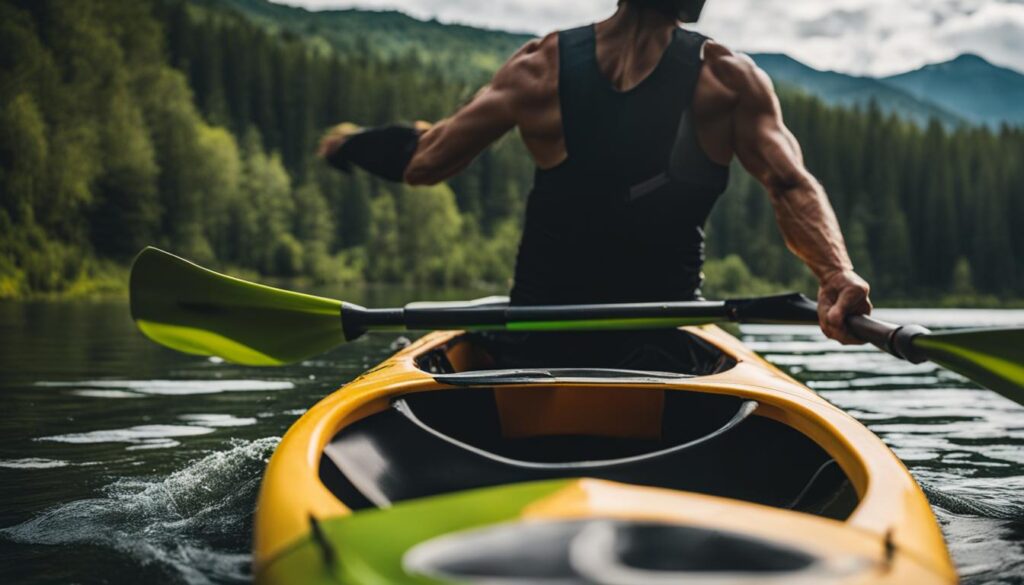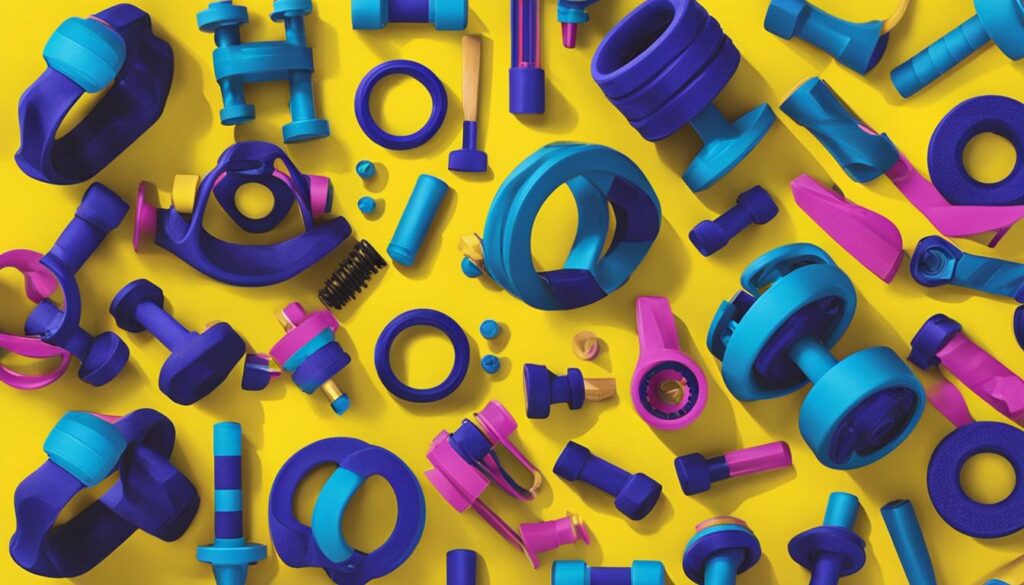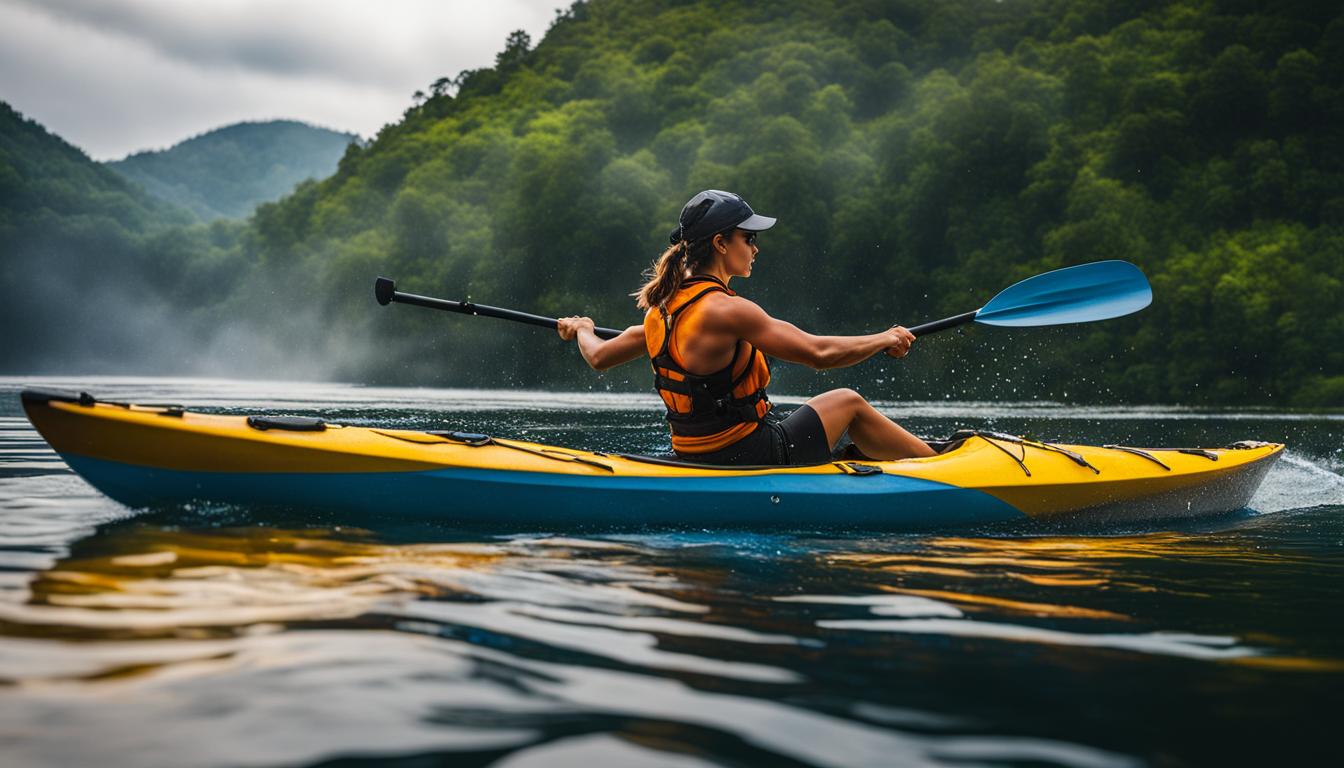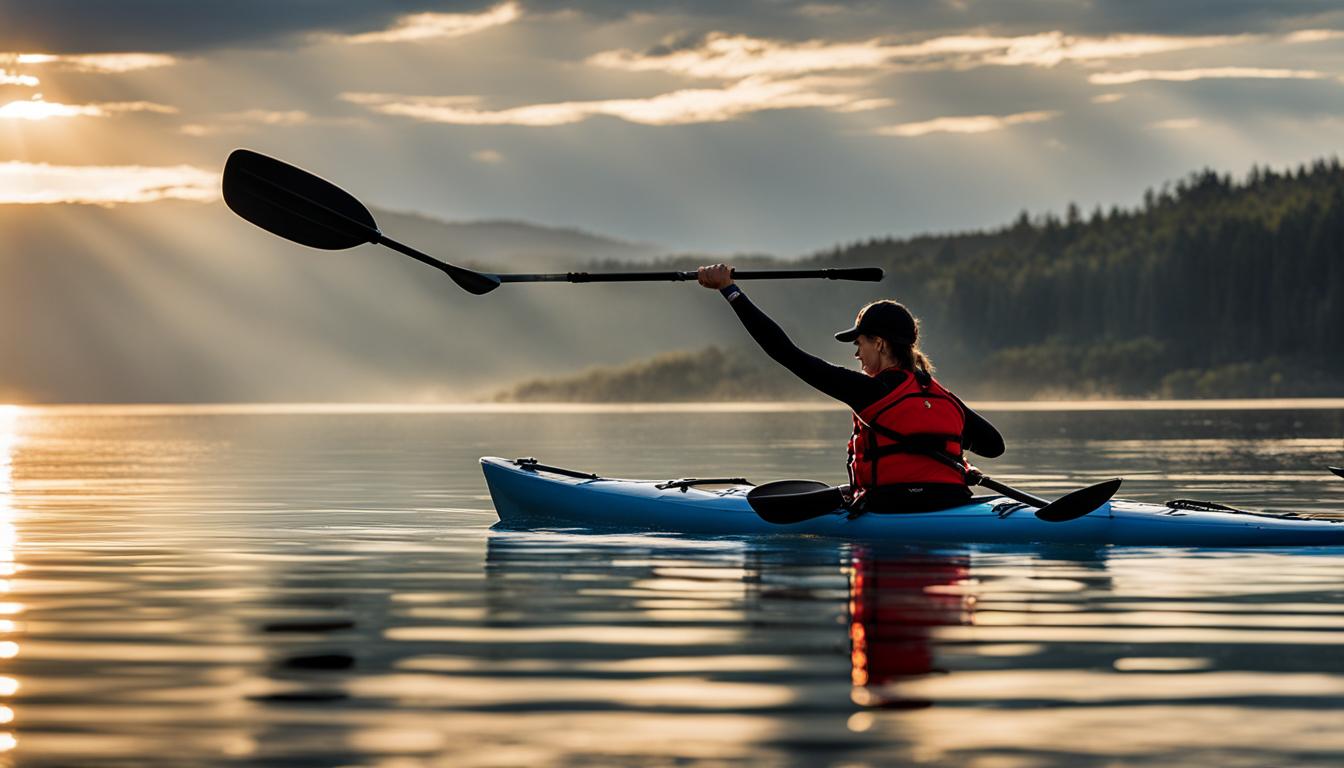Grip strength is a vital aspect of paddle control that plays a significant role in enhancing your performance on the water. Whether you’re kayaking or participating in other paddling activities, having a strong grip allows you to maintain control and execute precise movements with your paddle. In this section, we will explore techniques and exercises to improve your grip strength, ensuring a firm and reliable hold on your kayak paddle.
Key Takeaways:
- Grip strength is essential for optimal paddle control in kayaking and other water sports.
- Former tennis players often tend to grip the paddle too tightly, but a firm grip pressure of 4 to 8 on a scale of 10 is sufficient.
- Loosening the grip by focusing on the fingers and using the shoulder for power can improve paddle control and reduce discomfort.
- Grip strength training exercises like the bent over row, chest press, and pushups can help strengthen the muscles involved in paddling.
- Incorporating proper form, gradual progression, and adequate rest are crucial for safe and effective grip strength training.
Importance of Grip Strength for Paddling
When it comes to paddling, grip strength plays a vital role in ensuring control and stability on the water. The muscles used in paddling a kayak or canoe include the back, shoulders, chest, arms, hands, abdominals, and hips/legs. While the back is often considered the major player, each arm has a different role in the paddle stroke. A strong core is necessary for the rotation of the torso during the stroke. However, it is the forearms and hand muscles that are essential for maintaining a powerful and secure grip on the paddle, allowing for optimal control and efficiency.
Without sufficient grip strength, paddlers may struggle to maintain a firm hold on the paddle, leading to inefficiency in their stroke and reducing overall performance. Moreover, weak grip strength can also result in discomfort and fatigue, hindering endurance during long paddling excursions. Therefore, it is crucial for paddlers to focus on improving their grip strength to enhance their paddle control and endurance.
By including specific exercises that target the muscles involved in gripping and paddling, paddlers can effectively improve their grip strength. These exercises can range from traditional weightlifting exercises such as bent over rows, chest presses, and lat pulldowns, to functional movements like deadlifts and pushups that engage multiple muscle groups simultaneously. Additionally, incorporating specialized grip strength training tools such as hand grippers or grip balls can further enhance hand strength and endurance for kayaking or canoeing.

The Role of Grip Endurance
In addition to grip strength, grip endurance is also a crucial aspect of paddling. Endurance is essential for maintaining a consistent grip throughout a long paddling session or race, as fatigue can cause the grip to weaken and compromise control. To improve grip endurance, paddlers can include exercises that involve holding onto a weighted object for an extended period, such as farmer’s walks or static holds. These exercises help to simulate the prolonged grip required during paddling activities, resulting in improved endurance and stamina.
Overall, improving grip strength and endurance is fundamental for enhancing paddle control, efficiency, and performance in kayaking and canoeing. By incorporating targeted exercises and training techniques, paddlers can develop a strong and reliable grip that will contribute to their overall success on the water.
Paddling-Specific Strength Training Exercises
When it comes to improving your grip strength for paddling, there are several exercises that target the key muscles involved. These exercises focus on strengthening the back, chest, shoulders, triceps, and core muscles, all of which contribute to better paddle control and performance in the water.
One effective exercise for strengthening the back and shoulders is the bent-over row. This exercise can be performed using dumbbells or a barbell, and involves bending forward at the hips while keeping your back straight and pulling the weight towards your chest.
Another exercise that targets the chest, shoulders, and triceps is the chest press. This can be done using dumbbells or a barbell, and involves pushing the weight away from your chest and extending your arms fully.
To target the core muscles, exercises like cable rotations and twisting hip crouches can be effective. These exercises help to improve stability and rotational power, which are important for maintaining balance and generating power during paddling.
| Exercise | Muscle Group |
|---|---|
| Bent-Over Row | Back, Shoulders |
| Chest Press | Chest, Shoulders, Triceps |
| Cable Rotations | Core |
| Twisting Hip Crouches | Core |
These are just a few examples of the many exercises that can help strengthen your grip for paddling. It’s important to perform these exercises with proper form and technique, and gradually increase the weight or resistance as your strength improves. Remember to listen to your body and give yourself adequate rest and recovery time between workouts.
Additional Tips for Grip Strength Training
Improving your grip strength is essential for enhancing your performance in kayaking. In addition to the specific exercises mentioned in the previous section, here are some additional tips to help you increase your paddle grip strength:
- Focus on proper form and technique: Pay attention to your hand placement on the paddle and make sure you are using the correct grip. Practice holding the paddle with a loose grip, avoiding excessive tension in your fingers and wrists.
- Gradually increase resistance or weight: Start with lighter weights or resistance bands and gradually progress to heavier ones as your grip strength improves. This progressive overload will challenge your muscles and promote strength gains.
- Incorporate grip strength training tools: Consider using hand grippers or grip balls to specifically target your hand and forearm muscles. These tools provide additional resistance and can help to improve grip strength.
- Ensure adequate rest and recovery: Allow your muscles enough time to recover between workouts. Overtraining can lead to fatigue and increased risk of injury. Listen to your body and give yourself enough rest days.
By following these tips, you can effectively enhance your grip strength for kayaking and improve your paddle control. Remember to always prioritize proper form, gradually progress in your training, and give your muscles enough time to recover. Incorporating these strategies into your grip strength training routine will help you achieve better performance on the water.
| Tips for Grip Strength Training | Benefits |
|---|---|
| Focus on proper form and technique | Ensures optimal muscle engagement and reduces the risk of injury |
| Gradually increase resistance or weight | Promotes muscle strength and progress over time |
| Incorporate grip strength training tools | Targets specific muscles and enhances grip strength |
| Ensure adequate rest and recovery | Prevents overtraining and reduces the risk of fatigue and injury |
Equipment and Training Plan for Grip Strength Training
To effectively improve grip strength for paddling, it is important to have the right equipment and a well-designed training plan. The following section provides an overview of the equipment needed and a sample training plan to enhance your grip strength.
Equipment for Grip Strength Training
Having the right equipment is essential for effective grip strength training. Here are some key pieces of equipment that can be used:
- Dumbbells
- Resistance bands
- Pull-up bar or TRX straps
- Bosu ball
- Barbell
- Kettlebells
- Cable machine
These tools offer a wide range of exercises targeting different muscle groups involved in paddle control. They provide the necessary resistance and versatility to challenge and strengthen your grip.
Training Plan for Grip Strength
A structured training plan is crucial for making progress in grip strength. Here is a sample plan that you can follow:
| Exercise | Sets | Repetitions | Rest |
|---|---|---|---|
| Dumbbell Rows | 3 | 8-12 | 1-2 minutes |
| Resistance Band Pull-aparts | 3 | 8-12 | 1-2 minutes |
| Barbell Deadlifts | 3 | 8-12 | 1-2 minutes |
| Kettlebell Swings | 3 | 8-12 | 1-2 minutes |
| TRX Suspended Rows | 3 | 8-12 | 1-2 minutes |
| Cable Rotations | 3 | 8-12 | 1-2 minutes |
This plan includes a variety of exercises that target different muscle groups involved in grip strength. Perform 2-3 sets of each exercise, with 8-12 repetitions per set. Gradually increase the weight or resistance as your strength improves over time. Remember to rest for 1-2 minutes between sets to allow for proper recovery.
It is important to note that before starting any new fitness program, it is recommended to consult with a healthcare professional to ensure that it is suitable for your individual needs and abilities.

Conclusion
Grip strength is a crucial component of paddle control and performance in the water. Whether you’re a kayaker, a pickleball player, or any other paddling enthusiast, having a strong grip can make a significant difference in your ability to maneuver and control your paddle.
By incorporating specific exercises that target the muscles involved in paddling, you can improve your grip strength over time. Remember to focus on proper form and technique during your workouts to ensure maximum effectiveness and reduce the risk of injury.
It’s also important to give your body adequate rest and recovery between training sessions. Overtraining can lead to fatigue and hinder your progress, so listen to your body and take breaks when needed.
Developing grip strength will not only enhance your paddle control but also improve your overall performance and enjoyment of paddling activities. So, keep practicing, stay consistent, and have fun on the water!
FAQ
Why is grip strength important for paddling?
Grip strength is important for paddling because it ensures control and performance in the water. Having proper grip strength allows you to maintain a strong hold on the paddle, leading to better paddle control and overall performance.
How should I grip the paddle for pickleball?
In pickleball, it’s unnecessary to grip the paddle too tightly. Instead, grip the paddle in the fingers, like holding a bird, with a grip pressure of 4 to 8 on a scale of 10. This lighter grip allows for better comfort and performance.
What can I do to loosen my grip?
To practice loosening your grip, hold the paddle with your thumb, index, and middle fingers and perform forehand dinks. Focus on using your shoulder for power rather than relying too much on your wrist. This exercise will help you develop a looser grip for better paddle control.
Which muscles are used in paddling?
Paddling engages various muscles, including the back, shoulders, chest, arms, hands, abdominals, and hips/legs. Each arm has a different role in the paddle stroke, and a strong core is necessary for torso rotation. The forearms and hand muscles are essential for maintaining a strong grip on the paddle, while the hips and legs act as stabilizers for balance.
What exercises can I do to improve grip strength for paddling?
There are several exercises you can do to target the key muscles involved in paddling. These include the bent over row, chest press, lat pulldowns, deadlifts, pushups, and cable tricep extensions. These exercises focus on the back, chest, shoulders, triceps, and core muscles, which are important for paddle control. Other exercises like twisting hip crouches, kettlebell swings, and cable rotations can also enhance grip strength and overall paddle control.
What are some additional tips for grip strength training?
In addition to specific exercises, it’s important to use proper form and technique during training. Gradually increase resistance or weight as your strength improves and consider using grip strength training tools such as hand grippers or grip balls. Ensure adequate rest and recovery between workouts to avoid overtraining and listen to your body to prevent fatigue and injuries.
What equipment do I need for grip strength training and how should I plan my training?
For grip strength training, you’ll need dumbbells, resistance bands, a pull-up bar or TRX straps, a bosu ball, a barbell, kettlebells, and possibly a cable machine. These tools allow for a variety of exercises targeting different muscle groups involved in paddle control. To plan your training, perform 2-3 sets of each exercise with 8-12 repetitions per set, gradually increasing weight or resistance over time. Include rest periods of 1-2 minutes between sets. It’s important to consult with a healthcare professional before starting any new fitness program.





